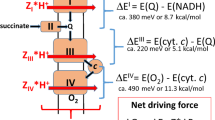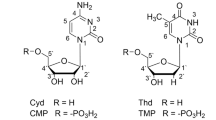Abstract
Abood, Gerard and Ochs1 claim that the respiration of cell-free dispersions and mitochondria of brain tissue was increased by the passage of electrical impulses between silver electrodes in the suspension medium. In general, increase in the respiratory rate of well-prepared mitochondria is consequent upon increase in the rate of removal of adenosine triphosphate, by addition of systems which catalyse its dephosphorylation, or through activation of the mitochondrial adenosine triphosphatase2. We were thus led to test the effect of electrical impulses on the adenosine triphosphatase activity of mitochondria, obtained from rabbit cerebral cortex, using the medium which had enabled the preparation of mitochondria of low initial adenosine triphosphatase activity from pigeon breast muscle3. For the adenosine triphosphatase assays the particles were incubated for 10 min. at 20° in a medium of the following approximate composition: 0.1 M potassium chloride, 0.05 M aminotrishydroxymethylmethane-hydrochloride buffer pH 7.4, 0.005M magnesium sulphate, 0.005–0.0075 M sodium adenosine triphosphate, and 5 × 10−5 M ethylenediaminetetraacetate. With 0.0075 M adenosine triphosphate, mitochondria from 60 mgm. of tissue liberated about 20 µgm. of inorganic phosphate under these conditions, and the activity was increased three-fold on addition of 10−4 M 2 : 4-dinitrophenol.
This is a preview of subscription content, access via your institution
Access options
Subscribe to this journal
Receive 51 print issues and online access
$199.00 per year
only $3.90 per issue
Buy this article
- Purchase on Springer Link
- Instant access to full article PDF
Prices may be subject to local taxes which are calculated during checkout
Similar content being viewed by others
References
Abood, L. G., Gerard, K. W., and Ochs, S., Amer. J. Physiol., 171, 134 (1952).
Lardy, H. A., in “The Biology of Phosphorus”, edit. by L. F. Wolterink, 131 (Michigan State College Press, 1952). Potter, V. R., and Recknagel, R. O., in “Phosphorus Metabolism”, edit. by W. D. McElroy, and B. Glass, 1, 377 (Johns Hopkins Press, Baltimore, 1951). Lardy, H. A., and Wellman, H., J. Biol. Chem., 195, 215 (1952). Potter, V. R., Lyle, G. G., and Schneider W. C., J. Biol. Chem., 190, 293 (1951). Siekevitz, P., and Potter, V. R., J. Biol. Chem., 201, 1 (1953).
Chappell, J. B., and Perry, S. V., Nature, 173, 1094 (1954).
Ayres, P. J. W., and McIlwain, H., Biochem. J., 55, 607 (1953).
Narayanaswami, A., and McIlwain, H., Biochem. J., 57, 663 (1954).
Webster, H. L., cited by Needham, D. M., Ann. Rep. Chem. Soc., 49, 275 (1953).
Greville, G. D., and Needham, D. M. (to be published).
Engelhardt, V. A., “Adv. Enzym.”, 6, 147 (1946).
Author information
Authors and Affiliations
Rights and permissions
About this article
Cite this article
CHAPPELL, J., GREVILLE, G. Effect of Silver Ions on Mitochondrial Adenosine Triphosphatase. Nature 174, 930–931 (1954). https://doi.org/10.1038/174930b0
Issue Date:
DOI: https://doi.org/10.1038/174930b0
This article is cited by
-
In vitro effects of silver nanoparticles on the mitochondrial respiratory chain
Molecular and Cellular Biochemistry (2010)
-
The sodium cycle in Vibrio cholerae: Riddles in the dark
Biochemistry (Moscow) (2005)
Comments
By submitting a comment you agree to abide by our Terms and Community Guidelines. If you find something abusive or that does not comply with our terms or guidelines please flag it as inappropriate.



